
Stick ‘em up!: A cop with a gun.
Watching too many Jimmy Cagney movies as a child made me think a gangster’s life as a possible career option. I could picture myself running a numbers racket, or selling moonshine, riding the running board while blasting the competition. Even the gangsters’ names were exotic: Al Capone, Bugsy Moran, John Dillinger, Tony Accardo. Then I turned six—discovered soccer and the fancy footwork of Jimmy “Jinky” Johnstone and Harry Hood which made me think playing for Celtic would be a better choice.
Gangsters and Grifters is a book of photographs compiled from the extensive crime archive of the Chicago Tribune. The book contains a collection of rarely seen photos of infamous gangsters, murderers, thieves, pickpockets, bandits, molls as well as the cops who brought them to justice from 1900-1950. These vintage glass-plate and acetate negatives captured many legendary moments in criminal history—from which this small selection has been culled.

Al Capone making an appearance in court, date unknown. Capone had a seven year reign of terror on the streets of Chicago during the 1920s. He was believed to have been responsible for the St. Valentine’s Day Massacre. He was eventually busted for tax evasion and sentenced to gaol. He suffered from tertiary syphilis and died of cardiac arrest in 1947.
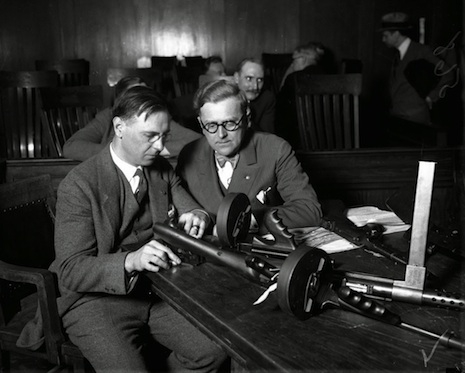
Cops examine guns suspected of being used in the St. Valentine’s Day Massacre, when six mobsters where shot dead—you’d have thought the cops might have been grateful. One of the shooters was thought to be mob enforcer Tony Accardo.
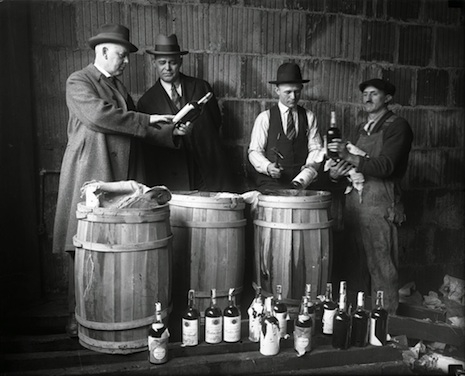
Prohibition helped the rise of gangsters like Al Capone, who ran hooch and illegal drinking dens. Here cops inspect some of the alcohol Capone and his associates were running.

Capone on another visit to court.

Legendary defense lawyer Clarence Darrow tried to get life sentences for thrill killers Richard Loeb, 18, and Nathan Leopold Jr., 19, when they were tried for the murder of 14-year-old Robert “Bobby” Franks. Darrow hoped to avoid a death sentence for his clients, so had them both plead guilty. Darrow blamed “Nietzsche’s philosophy” for Leopold and Loeb‘s crime, and managed to get them out of the electric chair and into life imprisonment. Leopold died in 1971, Loeb in 1936. Their killing for kicks inspired Patrick Hamilton‘s play ‘Rope,’ later made into a film by Alfred Hitchcock. Darrow has been played onscreen by Orson Welles, Kevin Spacey and Brian Dennehy; and Henry Fonda and Leslie Nielsen onstage.
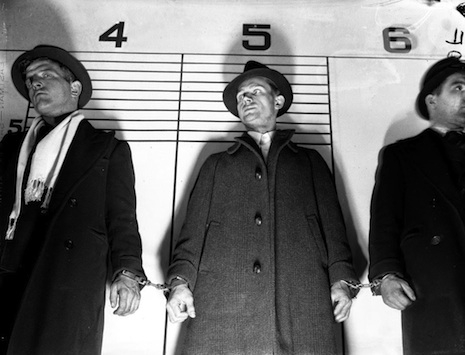
The usual suspects: bank robber and killer Joseph Schuster on ID parade between two cops.

Elliot Wisbrod tests his invention the bullet-proof shield against the bullets of police Lieutenants Frank Ballou and Samuel Peterson.

“Moonshine” Mary Wazeniak—the first woman to be convicted of selling fatal moonshine. Stick to mineral water if she’s buying a round.
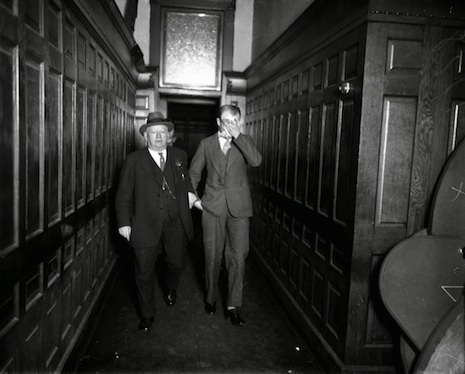
Never play cards with anyone called “Lucky” or “Fingers”—you’ll lose. Here’s William “Three Fingered Jack” White who was twice tried for the murder of policeman Edward Pflaume in 1925. He got off both occasions. Now, if that had been you or me…
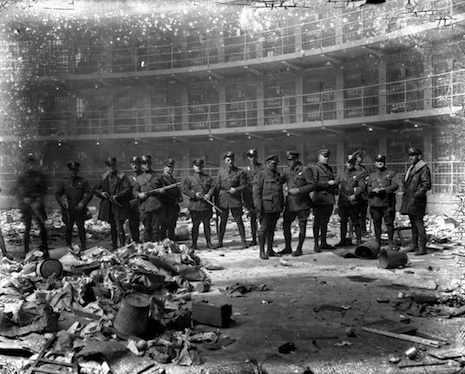
State Police restore order after 1,500 convicts rioted in the Stateville Prison in Joliet, Illinois on March 18, 1931.

John Dillinger robbed 24 banks and four police stations and escaped from jail twice. This is Dillinger being led through the court building at Crown Point, on Jan. 31, 1934, where he was on trial for the First National Bank robbery that occurred on Jan. 15, 1934 in East Chicago.

John Dillinger handcuffed to Deputy Sheriff R.M. Pierce during Dillinger’s murder trial hearing in Crown Point, Ind. His trial was scheduled for March 12, 1934, but Dillinger escaped from Crown Point prison on March 3rd, and carried out a further four robberies—stealing about $150,000. Dillinger was shot to death by G-Men outside the Biograph Theater, Chicago in July 22nd 1934—he was just 31.
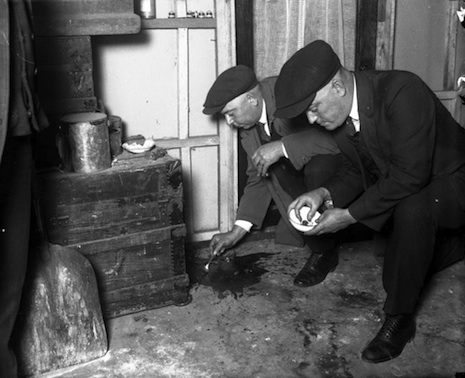
Early CSI—detectives look for clues.

So-called “girl bandits” Jean Buttick, 15, and Anna Varich, 16, were arrested while looting a house on South California Ave. in March 1927. This light-fingered pair were responsible for dozens of burglaries and when arrested were said to have “dripped booty.”
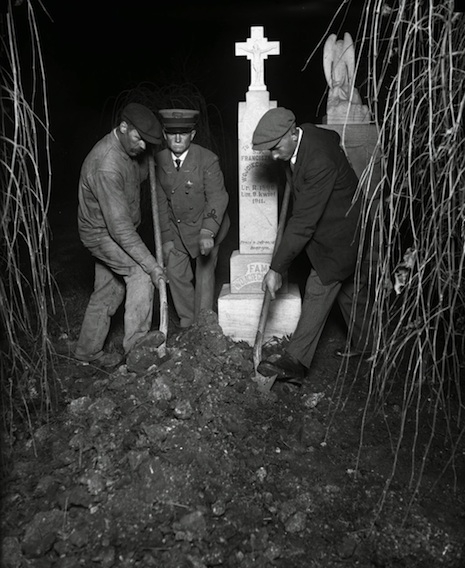
Digging up the bodies: Before the “Black Widow” there was Otille “Tillie” Klimek, whose was accused of poisoning her first three husbands and attempting to poison her fourth. The bodies of hubbies one to three were exhumed to build the case for poisoning. Tillie would jokingly tell anyone who would listen that her husbands were going to die, which led some to suggest she was a psychic rather than just a cold blooded killer. Though she was suspected of poisoning up to twenty people (fourteen of whom died), Tillie was only convicted for the murder of her third husband. In March 1923 and sentenced to life imprisonment, where she died in 1936.

D.O.A. part 1: Estelle Cantoumanos identifies her dead brother, John Kuesis, 33, who was murdered on December 1947. It soon turned out that Kuesis was slain by known criminals Thomas Daley, 42, James Morelli, 20, and Lowell Fentress, 19, who believed Kuesis had grassed them up to the cops over a robbery.
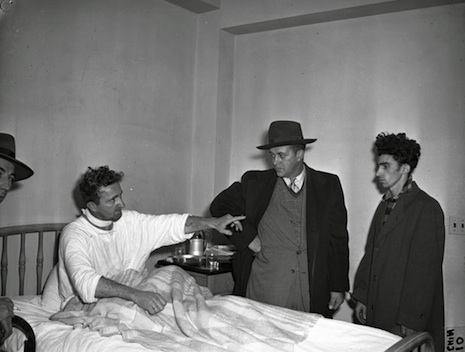
D.O.A. part 2: “That’s the dirty bastard that killed my brother”—Nick Kuesis points the finger at James Morelli—one of the trio of men charged with killing his brother John. Kuesis said Morelli was also the man who shot him in the neck.

Racketeer Carroll “Kickey” Corcoran, 35, was shot dead in his car on August 19, 1940, during the South Side handbook war. What odds would he have given for that?
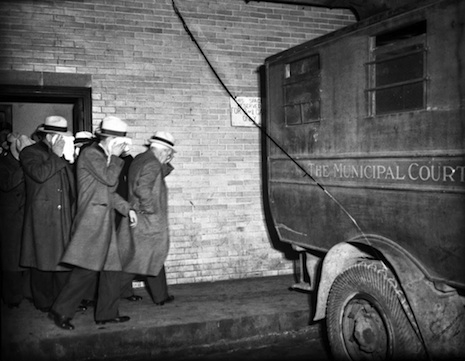
Book ‘em Danno—gangsters being led away.
H/T Vintage Everyday.